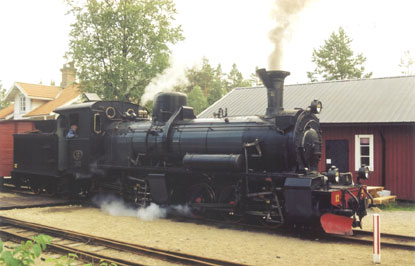
One of the ungue engines in Sweden were the three 0-6-6-0.s of DONJ, of two engines No.8 and No.12 has survied on JTJ.
Here No.12 taking a train with passengers stops in Tallås in summer 2001.
Photo by Ollie Ahokas
There is not much you can use from commercially available models, except for a pewter and brass kit from UGJ/Rimbo Grandé of a tank engine, which was used on line as #14. But unfortunally it spent much of its time as plant switcher in the huge paper works in Norrsundet. But never the less are the engines available that could be used on the semi freelanced version. Like the both of BEMOs steamers for RhB for H0m, they are pretty near the 2-6-0T.s. and 2-8-0.s. This means that you have to broaden the gauge from H0n3 to H0m.
The DONJ was rich on freight cars and many were purchased second-hand and rebuilt added on the variety.
Today the preserved line has added cars from narrow-gauge lines from the mid Sweden area, mostly from Byvalla Långshyttan line (BLJ), and Nordmarken Klarälven line (NlKJ) and Roslagsbanan (former SRJ, today RB). Especially passenger cars as the line originally had only a handful small two axle cars and a pair of 4-wheel cars rebuilt to combines.

This might be one of the typical Swedish freight cars on narrow gauge. A two-axle boxcar, with a typical Swedish arrangement of the ventilators on the sides of the car. Note the spoked wheels on this NKlJ car. Typical pre-war features on freight cars are the casted number boards, which were gradually replaced by painted on stencils or simplified lettering boards made of plate.

In the thirties the older designs were wearing out and higher capacity cars with arched roofs replaced the older designs. Like this car which also ran originally ran on Nordmarken - Klarälven line.

Some of the last railroad companies that constructed freight cars were NKlJ, as this very modern log car. This car looks like a half heartily built scratch building project as the seems are rather crudely welded on.

One of the most unique but quite common cars are various look alike stake-cars with removable steel plate sites so the cars could be used as gondolas as well. This design was and still is quite common in standard gauge operations.

DONJ was orginal allright, like take a check at this unique flanger. This car was pulled and the plows behind the car took care of that the roadway was cleared for the drainage.
More pics.

It is rather unusual that find the majority of any car type that ran on the original line. But how common is to find all? Yes, DONJ had hundreds of freight cars, but they were either stake cars or broadside flatcars. The longer cars were actually multipurpose cars, as they served as baggage-heating cars on passenger runs, or as boxcars on freight runs. This side displays the connection to the passenger cars, but the opposite end is blind.

This car has an interesting story, one of the original line up of orecars rebuilt to a one of the kind short boxcar.

The side view of one of the longer cars.

If the boxcars were rare on DONJ, so was this type of care very common. and eventually rebuilt in to different variations as this boardsided gravelcar.

Some of the shorter freight cars were extended to increase the capacity. This two variations here has been rebuilt originally to coke service, as the demand fore coke declined and the demand of chip wood increased, the cars stayed in roster to the very end.